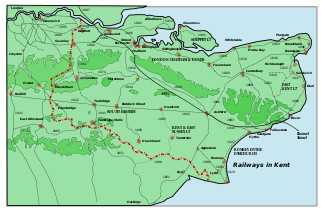Sheppey Light Railway
The Sheppey Light Railway was a railway on the Isle of Sheppey, Kent, England which ran from Leysdown to Queenborough, where it connected with the South Eastern and Chatham Railway's Sheerness Line. It was engineered by Holman Fred Stephens and opened in 1901 and closed on 4 December 1950.[1] Originally there were stations at Sheerness East, East Minster on Sea, Minster on Sea, Eastchurch and Leysdown. Two halts were opened in 1905 at Brambledown and Harty Road.[1]
| Sheppey Light Railway | ||||||||||||||||||||||||||||||||||||||||||||||||||||||||
|---|---|---|---|---|---|---|---|---|---|---|---|---|---|---|---|---|---|---|---|---|---|---|---|---|---|---|---|---|---|---|---|---|---|---|---|---|---|---|---|---|---|---|---|---|---|---|---|---|---|---|---|---|---|---|---|---|
Legend | ||||||||||||||||||||||||||||||||||||||||||||||||||||||||
| ||||||||||||||||||||||||||||||||||||||||||||||||||||||||

Operation
For the first few years after opening the SE&CR operated the line using standard locomotives and stock. However the light traffic on the line required a rethink.
- Petrol railcars
In 1904 trials were carried out of two petrol engined railcars. One only had seats for four passengers, insufficient even for this byway, but the larger 16 seat railcar proved satisfactory. Unfortunately it proved impossible to find a motor mechanic on Sheppey to maintain it in those early days of internal combustion so the SE&CR had to stay with steam power.
- Steam railmotors
The solution was a steam railmotor - a small steam engine permanently coupled to a carriage portion. Two were bought in 1905, one for the Sheppey Light and one for the equally remote Hundred of Hoo branch on the other side of the Medway estuary. A further six were acquired in 1906 for use on other lightly used services. The railmotors remained in use until the outbreak of World War I. The steam engine components were scrapped but the carriage portions were united in pairs, coupled over a shared bogie, and in this format they remained in use on Sheppey, hauled by normal steam engines, until the line's closure.
- Goods traffic
As the steam railmotors did not have enough power to pull goods wagons, the SE&CR sought out a small engine for the daily goods service. One, No. 54 Waddon, was obtained secondhand from their neighbour and rival, the London Brighton and South Coast Railway. This was one of that railway's famous Terrier class tank engines. This particular example survived into British Railways days and is still preserved, albeit as a static exhibit, in Canada's National Railway Museum.
References
Sources
- Kidner, R. W. (1985). Southern Railway Halts. Survey and Gazetteer. Headington, Oxford: The Oakwood Press. ISBN 0-85361-321-4.
Further reading
- Harding, Peter A. (1984). Sheppey Light Railway. P.A.Harding. ISBN 0950941409.
- Hart, Brian (1992). The Sheppey Light Railway. Wild Swan Publications Ltd. ISBN 1874103097.
- Scott-Morgan, John (1978). The Colonel Stephens Railways: A Pictorial Survey. Newton Abbot: David & Charles. ISBN 0 7153 7544 X.
External links
- The railway, via Colonel Stephens Society
- The railway, via The Colonel Stephens Railway Museum
- Images of the line, via Yahoo
- The railway, via Sheppey Website
- The railway, via John Speller
- Last day passenger train, via Trevor Edwards
- Line closure, via National Railway Museum
Coordinates: 51°23′58″N 0°50′17″E / 51.3994°N 0.8380°E